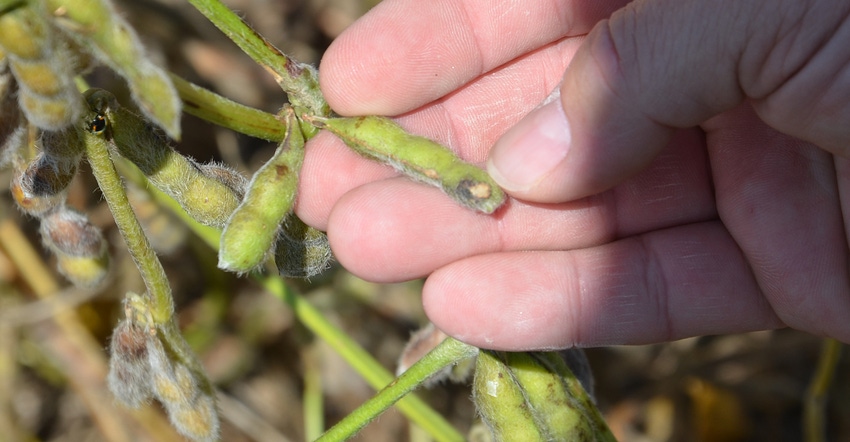October 31, 2018

Soybean grain quality was poor in some parts of Indiana and better elsewhere. What should I think about as I strive for better grain quality in 2019?
The Indiana certified crop adviser panel answering this question includes Andy Like, Syngenta sales rep, Vincennes; Jeff Nagel, agronomist, Ceres Solutions, Lafayette; and Darrell Shemwell, agronomist, Posey County Co-op, Poseyville.
Like: In many areas, soybean grain quality was compromised due to two main factors: frogeye leaf spot and stinkbug feeding damage. The first step in preventing these problems next year is to scout your fields throughout the crop year and make applications of fungicides and/or insecticides to prevent diseases and insects from causing grain quality issues.
In addition to causing poor grain quality, frogeye leaf spot and stinkbug caused significant yield loss, especially in central Indiana. If you’re not confident in your ability to scout for these pests, seek out a CCA to help scout.
Nagel: There are several insects and pathogens that cause soybean quality concerns. Frogeye leaf spot was more widespread this past year, and some varieties were more susceptible. The causal pathogen survives on infected seed and/or residue. Warm and humid conditions in 2018 were ideal for frogeye leaf spot. While foliar symptoms are most common, some stem and pod lesions can also develop. Sometimes the fungus can grow through pod walls and infect the seed, resulting in discolored and/or shriveled seed. Frogeye leaf spot is best managed by selecting high-yield varieties with resistance, using a seed treatment and applying foliar fungicides around R3, or beginning pod stage, if needed.
Stinkbugs and bean leaf beetles can also feed on soybean pods. Stinkbugs can pierce the developing seed through the pod wall. Bean leaf beetles can feed on pod walls, leaving a thin membrane. In both cases, feeding damage can predispose seeds to moisture and fungi that can also cause discolored and shriveled seed. Later-planted beans are most attractive, but insects are sporadic. Any field can be impacted.
Late-season pod feeding is often overlooked. Future management requires field visits to assess pod feeding while pods are still green. A foliar insecticide may be warranted if 5% to 10% of pods show feeding. A sweep net is a good tool to have for monitoring late-season pod feeders to better gauge insect pressure.
Shemwell: Cercospora leaf spot has probably been more widespread than other diseases this year, along with frogeye leaf spot. Cercospora leaf spot symptoms are bronzing or purpling of leaves and a purple stain on beans. Cercospora leaf spot and purple seed stain are caused by the same fungus. Cercospora is more prevalent when we have a warmer, wetter growing season.
In most years, we also see some seed damaged by stinkbugs. This can cause seed abortion and shriveled seed.
When thinking about better seed quality, always start out with good quality seed and genetics. Check disease ratings to see tolerance to frogeye leaf spot and other leaf diseases. Seed that’s treated with a fungicide and insecticide will get beans off to a better start. Rotate crops so you can alleviate some diseases.
Spray with a foliar fungicide and insecticide at the R3 to R4 growth stage to help minimize damage. However, cercospora leaf spot that comes in later will affect seed quality even if you sprayed a fungicide at R3.
You May Also Like




